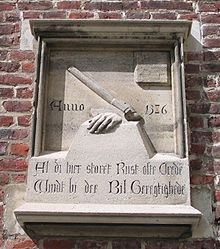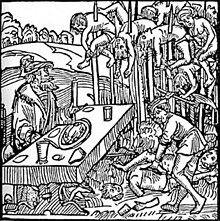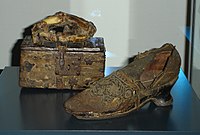Dead hand
The hand of the dead is the severed hand of a deceased person, mainly of the executed , which was used as a remedy in folk medicine in Europe and as a talisman . According to folklore, magical rituals and healing methods with the hand of the dead belong to the customs of so-called blood superstition , according to which the body parts and juices of humans and animals were assigned special powers. Due to the limited availability of dead hands, the practices were also carried out with individual dead fingers. In order to get hold of the dead hands, they were often severed immediately after the executions. Since looting of places of execution and the severing of body parts for magical-healing purposes were not uncommon, for example hanged people were guarded by the police or government agencies tried to prevent the theft of body parts through special decrees. Nevertheless, a larger number of dead hands ended up in pharmacies, as executioners generated additional income with their sale. In the 19th century, the massive importation of Egyptian mummies met the demand for dead hands in the pharmacy trade; Mummy parts that were not sold individually were offered as powder ( Mumia vera ) until the 20th century. Mummified or moist hands were common objects in alchemical collections and natural history cabinets .
Dead hand in medicine

As pars pro toto, the dead hand represented the entire dead body, especially the original ability to “be active” by hand, so to speak as a symbol of a still existing ability to act. This presumed active component of the dead hand was used in folk medicine for the treatment of a wide variety of diseases, whereby it was assumed that the pathogenic causes were transferred from the patient to the dead hand. The hand of the dead served as a last resort "to remove stains , malignant ulcers , cancer and lichen (non-infectious skin diseases ) , which were covered with it so that they should disappear just as the hand of the dead decays in the earth". But toothache , rheumatism and overlegs should also disappear by brushing a dead hand. The hands of dead children (even without being severed) were considered to be particularly medicinal and were used for sore throats and the so-called goiter ( goiter ).
On the basis of a pagan sacrificial ritual revealed in the body parts of the executed, it was assumed that primarily the body parts and the blood of the executed had protective and healing properties. This was the reason why audiences often tumbled over the blood of the victims at executions. However, hand relics were also venerated by saints in the spirit of a Christian sacrifice myth when they asked for healing. Hand relics are known from the Blessed Edigna von Puch and Saint Blaise von Sebaste .
Dead hand as a protective talisman
The hands and fingers of those who were executed also have auspicious and protective properties as a pagan symbol of “participation in this Atonement through appropriation of some bodily part” . The dead hands would have the ability to open locked doors and locks or to deter thieves as a protective fetish. Adolf Wuttke writes about this:
“Everything that comes from someone who has been executed brings good luck: a phalanx or other small bones of a 'poor sinner' kept in the purse creates plenty of money and never lets the purse become empty; if you carry it with you, it protects against vermin and protects the thief so that the robbery does not wake up (...) a thief's thumb placed next to or under the goods gives the merchant luck. "
Dead hand in art
In literature, the motif of the hand of the dead appears varied, be it as an expression of demonic power or possession or as an expression of the idea of revenge when the hand of a murdered person accuses his murderer. The latter is the case, for example, in Richard Wagner's opera Götterdämmerung , when Hagen kills King Gunther and tries to appropriate Siegfried's severed hand along with the magic ring. The latter then rose threateningly to accuse Hagen of Siegfried's murder. According to Germanic legal custom, the "lawsuit with the dead hand" was a possibility to bring a murder charge to court with the severed hand or finger of the allegedly murdered person. Body parts of victims with this legal representative function were also called body marks.
As part of archetypal magic potions , hands or fingers are often indispensable, as is the case in William Shakespeare's Macbeth , when the three witches, among many other ingredients, cannot do without severed fingers in the cauldron:
"Finger of birth-strangl'd babe / Ditch-deliver'd by a drab / Make the gruel thick and slab."
In the German translations by Dorothea Tieck or Christoph Martin Wieland it says “Hand of the same strangled boy, whom Metz gave birth in the ditch” or “Hand of the child, strangled with cord / Dreckgeborn von einer Hur” / Power the broth magnificently pure. "
The moving hand of the dead is an often used motif in mummy and horror films . A well-known theming can be found in the expressionist horror film Orlac's hands from 1924, which is based on the novel Les Mains d'Orlac by Maurice Renard and has been remade several times . In its satirized form, the dead hand appears as "Icy Cold Hands" (in the English original "Thing T. Thing") in the film adaptation The Addams Family based on the comics by Charles Addams from the 1930s.
Dead hands in existing collections
Mummified dead hands found their way into today's collections from older natural history cabinets or as a chance find during demolition work. The mummified "Black Hand" from Hohenlimburg Castle is well known . After a lightning strike in 1811 and the subsequent demolition work on the burnt-out tower hood, the dead hand was found as a walled-in relic. It is unclear whether it is a protective magic or a body mark that is no longer required. The so-called "Goslar Mummy Hand", which was found in the attic of the town hall of Goslar in 1708 , is, according to initial investigations, more of a dead hand from a criminal trial.
literature
- Christiane Wagner, Jutta Failing: Hacked on the head many times ... Gallows and executioners in Hesse . Naumann, Nidderau 2008, ISBN 978-3-940168-17-7 , pp. 123ff.
- Adolf Wuttke, Detlef Weigt (ed.): The German popular superstition of the present . Superbia, Leipzig 2006, ISBN 3-937554-19-X (first edition 1860 by the Rauhen Haus agency in Hamburg).
- Karl Eduard Haase: Folk medicine in the county of Ruppin and the surrounding area. In: Journal of the Association for Folklore 7, 1897, ISSN 0179-0064 , p. 70ff.
- Carly Seyfarth: Superstition and sorcery in the folk medicine of Saxony. A contribution to the folk medicine of the Kingdom of Saxony. Reprint of the Leipzig 1913 edition. Olms, Hildesheim 1979, ISBN 3-487-06835-4 ( Folklore sources II. Superstition 2), (At the same time dissertation at the Philosophical Faculty of the University of Leipzig , 1913).
Web links
Individual evidence
- ^ Meyers Konversationslexikon, Verlag des Bibliographisches Institut, Leipzig and Vienna, Fourth Edition, 1885-1892, Volume 19: Blood superstition
- ↑ Wuttke 1860, p. 101
- ↑ Wuttke 1860, p. 104f
- ↑ Wuttke 1860, p. 106
- ↑ B. Stern: History of Public Morality in Russia - Volume 1, Culture, Superstition, Manners and Customs , Chapter 15: Theft. 1907
- ↑ Wuttke 1860, p. 104
- ↑ Wagner and Failing 2008, p. 124
- ^ Report by NDR-online from November 8, 2006

